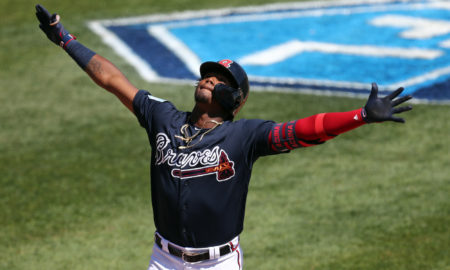Reserve Clause (Almost) Fifty Years Later: A Closer Look
 Who says the new, younger, more analytically oriented general managers are not astute baseball men?
Who says the new, younger, more analytically oriented general managers are not astute baseball men?
Not Ronald Acuña. Not his family. And certainly not his financial planner, who suddenly has a lot of money to manage. Because the eight-year, $100 million contract the 21-year-old Acuna signed on April 2 is guaranteed money. And with the two additional option years, the contract could be worth $124 million at his age-32 season. Adding the numbers up, Acuna will earn $39.5 million his first six seasons.
In contrast, consider that Mookie Betts earned $33 million his first six seasons in the major leagues without any extension, while Bryce Harper earned $25.7 million his first six seasons.
Betts has already turned down Boston’s initial $200 million foray, offering them a polite “no, thank you.” Certainly, $30 million a season, or perhaps more than that, awaits him next season as a free agent, probably bringing Betts close to $100 million for his first eight years in baseball, if he doesn’t establish his own new compensation record, as Bryce Harper did for 10 minutes before Mike Trout blew away that precedent.
Mike Trout did pretty well his first six years, too, earning $44 million, and he’s scheduled to earn another $71 million the next two years. So, Trout will earn $115 million his first eight years in the majors. Not shabby. And like Harper, Trout’s deal continues on, in his case, until his age-40 season.
Perhaps, Acuna might’ve faired better long-term had he progressed through the six earning stages before free agency, waiting for his arbitration seasons (his fourth, fifth, and sixth seasons) to begin to earn bigger money (like the $20 million Mookie Betts will earn in this, his last arbitration season before free agency). But Acuna chose not to wait. And as a young player, if he did opt for financial security, choosing to leave some money on the table on the back end, who can blame him? Acuna knows he is guaranteed $100 million the next eight years, no matter what, short of interplanetary war with Jupiter. That must be a comforting thought for a 21-year-old.
Without the Reserve Clause …
Athletes are players first, but in today’s baseball, they are also marketing tools for their team’s entertainment products, especially if they’re among the best players on the roster. These are the players highlighted on team promotional material, television marquees, bobblehead dolls, t-shirts and the like. They may even be the promotional faces of their teams. So, they carry more value than merely athletic skill. And lastly, their signature on a contract means more new season ticket holders—and that’s revenue up front, before a game is even played. Teams like that.
As baseball has grown as a business first, and sport second, these marketing and promotional capacities are important to the image of the team. Clearly, 100 years ago, baseball was only learning how to exploit the value of their stars. In newspapers. On radio.
Unless the player was Babe Ruth.
Now, without the Reserve Clause, without legally retaining the rights to every player on the roster, constructing a roster within the financial constraints of a team’s budget is a general manager’s greatest challenge.
Some realities. When the Reserve Clause was in effect, no baseball player ever approached a seven-figure annual season contract. Contracts were renewed yearly, automatically, so there was no need for a multiyear contract.
Had the Reserve Clause not been overturned in 1975, it’s debatable if any annual player contract would ever have reached, if not extended, seven-digit contracts or beyond. In fact, even with free agency, it would be another 22 years before Albert Belle was offered the first eight-figure, $10 million salary by the Chicago White Sox in 1997. In contrast, Nolan Ryan was the first $1 million a year player circa 1980.
However, after the Reserve Clause was overturned, the first player contracts offered to Andy Messersmith, Jim “Catfish” Hunter, Reggie Jackson and others, were seven-figure, multiyear agreements. Why? Because contracts had been automatically renewable after every season for 100 years. So, multiyear agreements were necessities if contracts could no longer be renewed year-to-year. Players had to be retained without threat of their loss to other teams.
The highlight of this new system pitted owner against owner in bidding wars for the sexiest player’s services. And what seemed like a small fortune to these players, who had been accustomed to compensation amounts in the thousands of dollars under the Reserve Clause, was a mere pittance to owners. And as owners bid up the ask for their next new toy, the players found themselves agreeing to multiyear deals for more money than they had ever imagined before.
So, as it grew, the free agency system raised financial expectations among the players. And as multiyear deals offered by active bidders reached and exceeded eight and then nine figures, players who had to work two jobs 50 years ago were now driving expensive cars from their mansions in the suburbs to the ballpark.
And all of this because of the avarice of ownership whose financial miscues became the basis for players’ inflated sense of value.
But, now that the half-billion dollar, multiyear contract is coming to a stadium near you, perhaps as soon as next season, local ownership has become hypersensitive to the public musings of every high-profile agent pontificating about the pricey value of their clients.
Even the Yankees, Dodgers and Red Sox sweat when they think about the coming $400 and $500 million dollar players. And those teams can afford indecent payrolls. Witness the fact these three teams passed on Harper and Machado because the dollars were out of whack with expected contributions. Or why?
This could be why Boston passed on Craig Kimbrel, who supposedly wanted a six-year contract. Boston could have handled another $100 million added to payroll if they thought Kimbrel was essential. They obviously thought he wasn’t key to winning.
Whereas Boston signed the 26-year-old Xander Bogaerts on April 1 to a six-year extension for $132 million. He will be paid the $12 million he is scheduled to earn this year, and then a six-year, $120 million extension will kick in for his age-27 season. During his age-30 season, following the 2022 season, Bogaerts can, if he chooses, exercise an opt-out clause and choose free agency again. Otherwise, if he plays through the complete contract, it’s reported there is another $20 million option for 2026.
That’s baseball today.
But, If Your Name’s Eloy Jimenez …
You may represent a new trend in baseball economics.
Eloy Jimenez agreed in March to a six-year, $43 million deal with two option years plus a $5 million signing bonus. The contract also contains two option years that, if exercised, will bring the total value of the contract to $75 million over eight years, when he will be 31 years old. The groundbreaking nature of this contract is Jimenez has yet to play any significant time in the major leagues. He is a rookie.
So, is this a new trend in baseball?
A contract that pays a rookie or second-year player substantially more money than the player would earn his first three pre-arbitration seasons, and then less money on the backend of the contract, so the team wins as well as the player. Is the new math here that teams are now tendering contracts to their best young players who will not have to wait until their seventh season to see big money?
Are these deals statements about the plethora of money freely flowing through the game? Do they speak to the fact that teams are now willing to take (informed) risks on young players and commit tens of millions of dollars to them in the hope the deal will pay off financially, and on the field. Now, and 10 years from now. Because there is so much money in the game?
Is this the way the new, younger, analytically oriented general managers are constructing rosters? Creating cores of solid players at key positions whom they can build around by judiciously allocating money for other players deemed critical to a winning culture.
This is the message of today’s baseball economics. Money is available, but only for the right players, as judged by team analytics and talent evaluators. Money will be allocated for top players, or those with the greatest promise. Those in the middle will have to accept what they can get.
That’s a player like Neil Walker. Walker accepted a $17.2 million Qualifying Offer from the New York Mets in 2016, then waited and waited for a contract before accepting a $4 million dollar one-year contract from the Yankees in 2018. This year, he faced the same uncertainty, and joined the Miami Marlins on a one-year, $2 million contract. Walker wanted to play baseball, and he took what was out there. Hey, it’s a lot better than landing a job at Walmart.
That’s baseball Eloy Jimenez style. Today’s baseball.
























